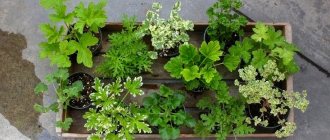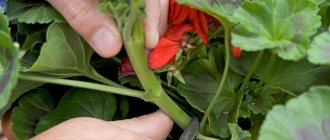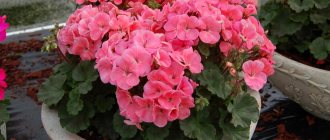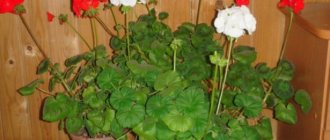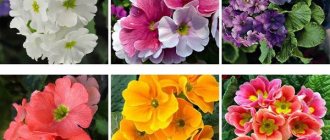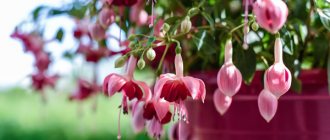In everyday life, pelargonium is most often mistakenly called geranium. Systematically, it belongs to the “Geranaceae” family, which includes the genus “Geranium” and “Pelargonium”. Our usual indoor flower belongs to the pelargonium genus.
Representatives of the genus “Pelargonium” are perennials native to South Africa. Among them there are dwarf varieties, the height of which is no more than 12.5 cm, as well as giants with stems up to 1 m.
The plant needs pruning every few years. Fortunately, geranium grows very quickly and gains a height of 25-30 cm in a year.
The plant has a long flowering period - starting in early spring and ending in late autumn.
Growing geraniums in the home of flower growers is prompted not only by a desire for beauty, but also by childhood memories. Without any doubt, it can be called a plant with history. After all, it is not at all surprising to see geraniums in a house where older people live. Planting pelargonium is already a tradition.
| Growing quickly. In one season, the plant gains 25-30 cm in height. |
| Blooms from late spring to early autumn. |
| The plant is easy to grow. |
| Perennial. Rejuvenate every 2-3 years. |
What is pelargonium
Pelargonium is native to African savannas. The heat-loving crop easily tolerates dry air. Plants of this genus have straight and creeping branched stems. They have slightly pubescent leaves, round in shape, palmate or palmately dissected. The color of the foliage of different species varies from light green to emerald. Some representatives of the genus have light leaf blades with dark patterns.
The umbrella-shaped inflorescences of the culture consist of 20 five-petaled flowers. Their petals are painted in white, yellow and red in all shades. Varieties with double flowers have been bred. The fruit is a capsule with retained sepals.
Description of geranium
Pelargonium is a source of valuable geranium oil. The flower secretes phytoncides that kill microbes. In cosmetology, indoor geranium extract is used as a component of masks for the face and hair. In folk medicine, geranium oil is used against inflammation, stress, and to improve blood circulation.
Pelargonium species
“Granny's little balls” is what the common people called the most common (zonal) types of pelargonium. Today there are about 75 thousand varieties and hybrids of the crop. The species diversity is impressive in the shape of the flowers and the brightness of the inflorescences:
- Rose-bud Zonal. Double showy flowers look like roses. In inflorescence they look like a miniature bouquet. A rare species found in the collections of experienced flower growers.
- Tulipe-bud. The tulip-shaped variety was obtained through a spontaneous mutation of the plant. The inflorescences look like a bouquet of unopened tulips.
- Stellar Zonal. Due to the pointed shape of the petals, pelargonium is called “star-shaped”. Varieties with double flowers of various colors have been bred.
- Cactus. The flowers of cactus-shaped pelargonium are large, with pointed, needle-shaped petals. The inflorescence has a perky “disheveled” appearance.
- Carnation. The inflorescences look like a miniature bouquet of carnations. The edges of the petals are serrated.
- Ivy-leaved. The ampelous leaves are similar to the leaf blades of ivy. Creeping stems can reach about 1 m in length. The flowers are often double. The variegated species is distinguished by dark leaves with a light web-like pattern and an inflorescence of simple 5-leaf flowers.
- Regal Pelargonium. Each flower is up to 7 cm in diameter. Its contrasting shades, veins highlighted in a different color, variegated spots, specks are a distinctive feature of the species. Flowers can have single or double petals.
- Angel. An ampelous appearance with a lush green mass and small flowers of delicate color. The middle or edging of light petals is often burgundy (red).
- Unique. The “Unicum” species combines several varieties with small petals of a multi-color palette. The leaves are intricately dissected. There are varieties with corrugated foliage, which emits an unusual smell. For example, the leaves of the Paton's Unique species smell fruity.
Pelargonium varieties
Description and history
Pelargonium is a herbaceous perennial plant belonging to the geranium family and brought from South Africa to Holland, and then to France and England. The flower has erect, slightly branched stems and reaches a height of 30-80 cm. The shape of the leaves is different for each pelargonium variety. The inflorescences are umbrella-shaped; they can have either few or many flowers of different shades (you can learn about different varieties of pelargonium, principles of care, and also see photos of flowers here).
Pelargonium has an antibacterial and soothing aroma. In addition, the flower is believed to bring mutual understanding to the family. Read more about the medicinal properties of pelargonium in our article.
Important! The main difference from cold-resistant garden geranium is that pelargonium is a heat-loving and indoor plant.
How to care for pelargonium at home
Growing pelargonium at home means regular watering, lighting, proper feeding and crown formation. If you follow the basic rules of care, the plant will never get sick and will grow lush and bloom profusely.
Lighting and temperature conditions
Indoor geranium needs 12 hours of daylight. The more intense the lighting, the more saturated the color of its foliage and inflorescences becomes. The culture does not tolerate strong shading. With a lack of lighting, the shoots become elongated and bare, the leaves become smaller, and the intensity of flowering is greatly reduced. During short daylight hours, flowers need additional illumination with phytolamps. Pelargonium is a heat-loving crop. does not tolerate cold well. In summer, the optimal temperature for the flower is 24-28°C. Pelargonium in the apartment is at a dormant stage in winter, so that in summer it blooms profusely again. From November, the crop needs to be provided with a lower temperature (12-16°C), constantly ventilating the room, but avoiding drafts.
Pelargonium growing conditions
Watering and moistening
Caring for pelargonium at home involves watering 2-3 times a week. The crop needs to be watered when the top lump of earth has dried 2 cm. Excess liquid causes the formation of rot on the roots. In winter, the humidification regime is reduced to 1 time every 7-10 days. If the flower pot is located near a central heating radiator, you will need to water the plant more often.
Hydrating geraniums
Indoor geranium can do without spraying, but it takes this procedure well. You can irrigate the flower only with warm, settled, rain or melt water. Calcium and iron contained in tap water leave unsightly stains on the leaves. Harmful substances clog the stomata of the leaf blade, making the crop's breathing difficult.
To improve the quality of tap water, pour 2 handfuls of peat into a bucket of liquid and leave to settle for 2 days. Harmful impurities will settle to the bottom, and the chlorine will evaporate. Before spraying or watering, carefully drain the water into another container. When draining, 1/5 of the volume of liquid is left in the bucket, which is not suitable for watering and spraying.
Loosening and fertilizing the soil
Caring for pelargonium
Pelargonium grows well in slightly acidic and neutral soil pH 5.4-7.3. You need to periodically check the indicator using a litmus indicator (you can buy a kit). Indoor geranium breathes through its roots, so the soil needs to be enriched with oxygen. To do this, after watering, carefully so as not to damage the root system, loosen the soil with a spatula or fork to a depth of 2-3 cm.
During the process of growing new shoots and forming inflorescences (from March to August), the plant requires a lot of nutrients. In order for the bush to be lush, it is necessary to add complex fertilizer for flowering plants to the soil every 2 weeks.
The main element of crop nutrition should be potassium. Nitrogen stimulates the growth of green mass of the bush and inhibits flowering, so the complex fertilizer should contain a minimum amount of it. An excess of nutrients in the soil is as detrimental to a plant as a deficiency. The fertilizer must be prepared according to the instructions for use. The best purchased fertilizers for pelargonium are:
- "Zircon";
- “Clean slate” for pelargoniums;
- “Royal Mix”;
- "Garden Club"
Pruning and shaping the bush
Proper care of pelargonium includes annual pruning of the bush. The crown is formed in the fall, after the crop blooms, or in early spring before active growth. If this is not done, the shoots will become very stretched and exposed at the bottom. The more you prune the bush, the thicker the crown will be.
Pruning promotes the formation of side shoots and the growth of greenery. Properly pruned crops bloom longer. Elite royal varieties of pelargonium are pruned only in the fall, starting from the second year of the growing season. Spring pruning deprives them of flowering.
How to prune pelargonium
Pinching the tops of shoots is a technique that gardeners use during the active growth phase. It allows you to maintain the splendor and beauty of the crown. When the top of a shoot with a pair of young leaves is pinched off, further growth of the shoot stops.
During the spring-summer growing season, branches of the bush that extend beyond the formed crown are periodically pinched. Faded flower stalks should be cut off immediately so that they do not draw back food.
Procedure for pruning pelargonium:
- Use sharp scissors disinfected with alcohol to remove dried, wilted leaves.
- Trim bare and long stems at the bottom node.
- Cut off the main branches by a third.
Transfer
Indoor geranium cannot be replanted often because the plant is under severe stress. You need to start replanting if the roots do not fit in the old pot and go into the drainage holes. The second sign that it is time to replant the bush is that the plant withers soon after watering.
Transplantation is carried out no more than once every 2 years. Caring for pelargonium requires annual replacement of the top layer of soil in the pot with a new substrate. A flower older than 4 years is replanted once every 3-4 years, because plant development slows down with age.
The process of transplanting pelargonium
The culture does not need a large pot. In it, indoor geranium grows fat and blooms poorly. Indoor geranium is not demanding on the composition of the soil. At home, you can prepare a soil mixture from turf soil, peat, humus and sand (2:1:1:1). To destroy pathogenic microbes, the soil is calcined in the oven for 10-15 minutes and allowed to cool.
A flower transplant is carried out as follows:
- Water the flower generously half an hour before transplanting.
- Scald a new pot with boiling water.
- Fill 1/3 of the container volume with drainage (small stones, vermiculite or expanded clay)
- Fill with soil, covering the drainage material by 3-4 cm.
- Carefully remove the bush from the old pot.
- Shake off the soil. If the roots are tightly woven into a ball of earth, there is no need to separate them.
- Inspect the root system. Trim dry, damaged, rotten, or too long roots.
- Sprinkle the cut areas with crushed activated carbon tablets for disinfection.
- Place the bush in the center of the pot and pour soil to the edge of the container.
- Gently press down the soil around the stem.
- Water and spray the flower generously.
Which window sill to choose for pelargonium
I want to please you right away - unlike most indoor plants, pelargonium feels great even in direct sunlight. You can even send your pet outside in the summer - in the fall you will be delighted to bring a huge lush bush into the house. The only exception is royal pelargonium, which needs to be handled more carefully, looking for cozy corners, and even shaded a little in summer.
In summer, also remember that pelargoniums growing on the windowsill will need a lot of fresh air, especially if the days are sunny and hot. Not being able to send your beauties outside, give them airing more often.
Lack of lighting can affect the condition of the plant - the beautiful leaves will become pale, and if your pelargonium has variegated foliage, it will quickly lose its beautiful pattern. It will tell you that the bush does not have enough light, because the pale leaves will eventually begin to turn yellow and fall off, exposing the stem. In such conditions, you will not expect flowering at all, so try to avoid such situations and immediately determine the most comfortable place for your beauty on a bright windowsill.
Disease and pest control
Improper care can lead to indoor geranium disease or pest damage. It is recommended to carefully inspect the plant once a week. Knowing what dangers await pelargonium, you can detect the problem by external signs and eliminate it:
| Name of disease or pest | How it manifests itself | Methods of healing |
| Edema (swelling from excess moisture) | Small yellow spots on leaves. |
|
| Gray rot |
|
|
| Late blight |
|
|
| Powdery mildew |
|
|
| Rust |
|
|
| Caterpillars | The leaves are eaten away and black excrement is visible on them. |
|
| Ticks |
|
|
| Thrips |
|
|
| Aphid |
|
|
| Whitefly |
|
|
Pelargonium and geranium - what's the difference?
Confusion with pelargonium and geranium is a case when nature “plays tricks” on people and combines incompatible things. And then people get confused and “rack their brains.” Thus, the famous biologist Carl Lynaeus hurried and in his classification of plants combined these two flowers into one group only because their seed pods at the maturity stage are similar, and the leaves have slight pubescence.
If you dig deeper, you find out:
These flowers cannot be crossed in any way.
Pelargonium is native to South Africa. The homeland of geranium is the Northern Hemisphere. Accordingly, their climate preferences are radically different.
Due to climatic preferences, the southern guest of our country is best used as a homemade one. It can be grown on the balcony, but it must be removed indoors for the winter.
For the same reasons, the northern beauty feels great in our climate, is grown outdoors and tolerates cold well.
Flowering occurs differently: the southern flower collects its buds in a small bouquet, while the northern flower mainly blooms with single buds.
An interesting coincidence. The southerner does not like cold weather and does not have blue flowers. But the northern woman does not like prolonged heat, and she does not have scarlet flowers.
Methods of propagation of pelargonium
At home, pelargonium is propagated by seeds, cuttings and dividing the bush. The first method does not guarantee the preservation of varietal characteristics of the crop. It is believed that a plant grown from seeds blooms more profusely - it forms up to 30 inflorescences per season. When annual pruning of a bush is carried out, the cut shoots are not thrown away, but cuttings are used to propagate the crop. An adult plant is propagated by dividing the bush.
Seeds
Growing pelargonium from seeds
Growing pelargonium at home from seeds is a troublesome task. First you need to buy or collect seed yourself. The seeds are in fruit boxes. The dried inflorescence is carefully trimmed and the fruits are removed. After this, they need to be kept in the fresh air (balcony, loggia) until the seed pods are completely dry.
Further actions:
- Soak the seed in a growth stimulator such as Kornevin for 2 hours.
- Fill a flat planting container with universal soil mixture.
- Plant the seeds in moistened soil to a depth of 1 cm at a distance of 2 cm from each other.
- Cover the container with plastic film to create a special microclimate for the seedlings.
- Place the container in a well-lit place. Seed germination temperature is 24-27°C.
- Caring for seedlings consists of systematic watering. It is better to water the soil with a watering can with a fine sieve to prevent erosion of the soil. The water should be warm, settled and soft.
- When the first 2 leaves appear, the seedlings are picked and transplanted at a distance of 5-7 cm from each other.
- When the sprouts reach a height of 10-15 cm, they are placed in permanent pots by transferring them.
By cuttings
It is better to harvest flower cuttings in March. Cut them with sharp, disinfected scissors or pruners. The cuttings should have 2-3 internodes 5-10 cm long. The cut is sprinkled with a crushed tablet of activated carbon. This will prevent the shoot from rotting.
Pelargonium cuttings
To form roots in cuttings, place the shoots in water or immediately place them in moist soil. The second option requires more careful care - constant moistening of the soil as the top 1 cm layer dries. When planted in the ground, the sprout takes root without stress, and the delicate roots are not damaged during planting.
To make the formation of roots in water faster, you need to add a growth stimulator like Kornevin to the liquid. Pelargonium seedlings do not need large pots, i.e. The root system of the flower is fibrous and is located close to the soil surface.
The optimal diameter of the pot for cuttings is 9 cm. Pots can be plastic or ceramic. The first ones retain moisture longer; if there is an excess of water, the roots in them can rot. Fired clay pots allow air to pass through. The root system in them is less likely to rot.
To plant cuttings, use the same soil as when transplanting pelargonium. When planting, the cutting should be deepened into the ground so that the lower node is in the ground. Root formation will begin from the place where the leaf used to be.
The seedling should be covered with a cut plastic bottle, placed on a well-lit windowsill, systematically watered and ventilated. No dew should accumulate on the inner surface of the bottle. Rooting will occur in 1.5-3 weeks.
Dividing the bush
The result of propagating pelargonium by dividing the bush.
The easiest way to propagate pelargonium at home is by dividing the rhizome. It is better to carry out the procedure during the next transplant. A plant propagated by dividing the rhizome will bloom next summer. Step-by-step instructions for the procedure:
- Water the plant generously 2 hours before propagation.
- Remove the flower from the pot by gently pulling the stems.
- Shake off the root system from the soil.
- Place the bush in a basin of warm water so that the soil leaves the roots.
- Rinse the root system under warm running water.
- Remove rotten, dry and damaged roots.
- Divide the rhizome into several parts with a knife. Each division should have several strong shoots with a growth bud at the base.
- Treat the sections with Kornevin powder.
- Shorten the shoots to 10 cm so that the plant does not waste extra energy feeding long stems and branches.
- Plant the cuttings into prepared pots. Their root collar should be lightly sprinkled with soil.
- Water the soil well with settled water.
- After 10 days, feed the plant with nitrogen-containing fertilizer to activate the process of growing green mass.
LANDING
Planting in containers
It is convenient to plant seeds in wide containers, no more than 5 cm high. Ordinary containers with lids, which can be purchased at any supermarket, are suitable for this. Fill the container with soil, leaving 1-1.5 cm of free space at the top. Make small indentations using a match or a regular stick at a distance of 4-5 cm. Place the seeds in these holes and carefully sprinkle with earth. After this, the crops are sprayed with warm water. To avoid temperature changes, it is necessary to control the humidity of the crops. Therefore, do not forget to cover them with a lid or cling film, and poke holes in some places.
On toilet paper
Place damp toilet paper in a container, place seeds on it at a distance of 4-5 cm and cover with a lid. After small white sprouts appear, they can be transplanted into the ground.
In peat tablets
You will need to soak the tablets in water, preferably warm. Keep in mind that tablets increase in size by 6 times when soaked. When the peat is wet, make a hole with a match and plant the seeds.
Problems when growing pelargonium at home
The cause of indoor geranium disease is always the same - improper care. Knowing what caused the painful state of the crop, the owner of the plant can easily correct the situation:
- The leaves are turning yellow. The cause of the problem is a lack of moisture in the bush or rotting of the roots. Replanting the plant and increasing the time between watering are ways to solve the problem.
- Yellowing of the edge of the leaf blade. The reasons are lack of moisture, the plant is cramped in the pot. Transplanting into an empty container with new soil will improve the condition of the crop.
- The plant does not bloom. The reason is non-compliance with the conditions of detention. It is necessary to move the crop to a well-lit place, adjust the watering regime, and feed the flower.
- It doesn't grow well. It is necessary to check the acidity of the soil. If the soil has become acidic, replant the pelargonium. Feeding the flower with nitrogen-containing fertilizer will improve its condition.
When to sow pelargonium seeds
You can sow all year round, but it’s best before winter, when we can easily control the lighting and temperature, which is important.
Our catalog contains perhaps the largest collection of pelargonium seeds: choose zonal varieties with huge inflorescences or chic hanging pelargoniums for flowerpots and hanging baskets.
PREPARATORY STEPS
Before planting, of course, we need to start planting the seeds. Let's divide the preparation into several simple steps:
- Select seed material. To do this, take high-quality elongated seeds. The seeds should be brown in color without any damage.
- Carry out scarification to speed up the emergence of seedlings. To remove the top layer, use any sharp object. However, do this carefully so as not to harm the seeds.
- Prepare the soil. You can buy it in a store or make it yourself. Take 2 parts of turf soil and one part each of peat and sand. Stir the mixture and place in the oven for a few minutes.
- Do disinfection. You will need a weak solution of potassium permanganate or hydrogen peroxide.
- Soak the seeds. This is necessary so that the seeds swell properly.
LIGHTING
Like any plant, good lighting is important for pelargonium. Therefore, in winter, due to gray and cloudy everyday life, you will have to take care of additional lighting. In the warm season, pelargonium is not kept in direct sunlight, but well-lit places are chosen. You should also know that this type of flower does not like drafts.
SEEDLING CARE
When shoots appear, the lid must be removed and the pelargonium should be placed in a well-lit place. Use a teaspoon to water. This will help you avoid stagnant water in containers. To prevent the roots from lacking oxygen, do not put off loosening until later.
When the seedlings have two leaves, you can start transplanting the pelargonium into separate containers. Place expanded clay at the bottom of the pots. The layer height should be at least 1-1.5 cm. Fill the container two-thirds with soil and plant the seedling. Next, spray the plant along the edge of the pot so as not to damage the earthen ball around the pelargonium.
Kinds
Pelargonium is a very numerous genus, which itself has 250 species. At one time and for a very long time, it was very popular in high society, among the nobility, and therefore breeders expanded its natural diversity many times over. Today, all this wealth is divided into 7 main groups: fragrant, unique, angels, succulents, ivy, zonal and royal.
Fragrant
Essential oils are made from the leaves of this species. It is the most fragrant of all the genus, which is reflected in its name. To feel its aroma, just lightly rub any leaf, or simply blow on the bush. At the same time, the smells themselves can be different: lilac, rose, ginger, pineapple or coconut.
The height of an adult bush is about one meter. Popular varieties include Lady Plymouth (menthol), Ardwick Cinnamon (cinnamon), Orange Fizz (lemon), P. tomentozum (menthol), Boths Snowflake, Eucament and P. laevigatum.
Uniques
Quite an old hybrid, unpretentious, bred 150 years ago from brilliant and royal. Mature bushes grow up to 50cm. Inflorescences are two-colored. The leaves have a distinct pleasant odor.
Angels
Hybrid. Outwardly they resemble a royal one, but are more miniature. At the same time, the flowers look like violets. It can bloom long and profusely. The leaves are toothed and have a unique aroma of lemon and mint.
The most popular varieties are: PAC Angeleyes Viola, PAC Angeleyes Light, PAC Angeleyes Randy, PAC Angeleyes Bicolor, PAC Angeleyes Blueberry, Eskay Saar, Swedish Angel and Quantock May.
Succulents
Need to steal an alpine slide or bonsai? Skulents are an excellent option for this. But it will not be easy to get them - they are sold in few places. But, thanks to the Internet and a large number of amateurs, there are chances if desired.
All varieties of this species are distinguished by some unusual detail: large flowers, unusual curved stem, etc.
The most popular varieties are: fluffy-leaved, fleshy, cortus-leaved, humpbacked, thick-stemmed and regular.
Ivy-leaved
As you might guess from the name, the leaves of this species are similar to ivy leaves - there are matte and shiny ones. Used by gardeners for growing on verandas or balconies, and a little less often for growing in hanging pots. Resistant to pathogenic fungi. Petals are regular, semi-double and double. There is a large selection of colors.
It is considered an annual, but can live longer at home.
The most popular varieties are: PAC Lilac Rose, PAC Kate, PAC Vicky, PAC Tomgirl, Ice Rose, Mozaic Sugar Baby and SIL Stellena.
Zonal
The garden species with the widest variety of choice - there are thousands of different varieties. The greens are tender, slightly fluffy, dark or light green, growing abundantly at the base of the bush. Flowers are found, both regular and double or semi-double. It is possible to choose the shape of the bud to your liking. There are tulip, rosebud, cactus and star buds to choose from.
The colors of the inflorescences are speckled, two-colored and even three-colored. The size of the bushes varies from the smallest about 10cm to 80cm.
It is considered an annual, but, as practice shows, it grows quietly at home for more than one year. To do this, you need to remove it into the house in the fall (if it grew on the balcony, for example) and store it at a temperature of about +23 degrees. And when it has completely faded, trim the bush so that about 10 cm is left from the ground and store until spring in a cool room at a temperature of about +15.
The most unusual varieties: Rumba Fire and Bravo Pastel.
Royal
Do you like bright and large fragrant flowers? Royal is your choice! Its buds open up to 8 cm in diameter. But this flower is quite capricious and you will have to tinker with it to see them. And the main thing in caring for it is a properly spent winter:
Watering is rare. At a high frequency, a lot of greenery will grow, but flowering will not occur.
Be sure to observe the temperature regime! +8 is best, but not more than +15.
Popular varieties among gardeners: Elegance Jeanette, Askham Fringed Aztec, PAC Aristo Salmon, Burghi and Rose Pope.



